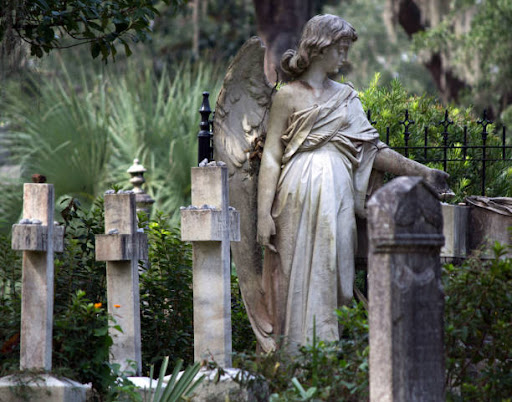Bonaventure is an Italian word meaning “good luck” or “good fortune.” The original land that would become Bonaventure Cemetery began as a plantation in the mid-1700s. English colonel John Mullryne and his son-in-law, Josiah Tatnall, would acquire around 9,000 acres on the Georgia coast to grow cotton, rice, and timber. Thousands of slaves would work the property and helped to make the venture a very successful enterprise. The family chose a 600 acre tract of land about three miles outside of Savannah on a bluff overlooking the Wilmington River, called St. Augustine Creek at the time, to build their home. The Mullrynes and the Tatnalls became very prominent members of Savannah and Georgia society. Colonel Mullryne served as Surveyor of Roads and Justice of the Peace. He also built the third lighthouse on Tybee Island in 1733. They were very successful, wealthy, generous, and highly respected. However, they were also British Tories and very loyal to King George III. This would become very problematic for the family during the Revolutionary War.
In the fall of 1779, American, French, and Haitian troops would overrun Bonaventure during the Siege of Savannah. The attempt to take Savannah from the British was a failed effort, and many of the rebels were killed. It is believed that over 600 French troops are buried in unmarked graves underneath the Bonaventure soil. When the British finally did surrender Savannah in 1782, the Mullryne and Tatnall families were no longer welcome because of their support for the crown. The Georgia government seized the plantation and sold it at auction to John Habersham.
John Habersham was a Princeton educated farmer and merchant. He was a patriot and fought bravely during the Revolution. He would rise to the rank of major before the war ended. He also served in the Georgia legislature and the Continental Congress. He died in 1799 and is buried in Colonial Cemetery in downtown Savannah. Just over ten years before his death, Major Habersham sold Bonaventure to Josiah Tatnall II, the youngest grandson of John Mullryne, returning the property to its original family. Josiah Tatnall II would have an illustrious life and career. He was a brigadier general in the Georgia Militia, a US Senator, and served as Governor of Georgia. His wife, Harriett Fenwick, was the first to be buried in the Tatnall family plot in 1802. Josiah Tatnall II is buried next to his wife. The last member of the family to own the plantation was Josiah Tatnall III. He sold the plantation to Peter Wiltberger in 1846.
Peter Wiltberger was a sea captain, merchant, and owner of the Pulaski Hotel. Under the ownership of Wiltberger, Bonaventure became a cemetery. It was incorporated as the Evergreen Cemetery Company of Bonaventure Plantation. Under the leadership of William Wiltberger, Peter’s son, the cemetery thrived. Due to “King Cotton” and the busy port, Savannah had become a boomtown. As a result of the newfound riches in Savannah, the citizens of the city built stunning houses, luxurious hotels, beautiful churches, and lavish monuments. It became one of the most beautiful and desirable cities in the United States. It was a perfect storm for Wiltberger. Savannaians love architecture, natural landscapes, honoring their heroes, and showing off their wealth. The garden cemetery was born! Bonaventure became the place that all prominent Savannanians wanted to be buried. As a friend of mine once said, “It is better to be buried in Bonaventure, than to live anywhere else.”
In 1907, the Evergreen Cemetery Company sold Bonaventure to the city of Savannah. The name was changed to Bonaventure Cemetery. In 1909 Mickve Israel, Savannah’s Jewish congregation, purchased land adjacent to the southern section of the cemetery further expanding Bonaventure. Today, the cemetery spans 106 acres and is home to over 30,000 graves and is one of the most beautiful cemeteries in the United States.

